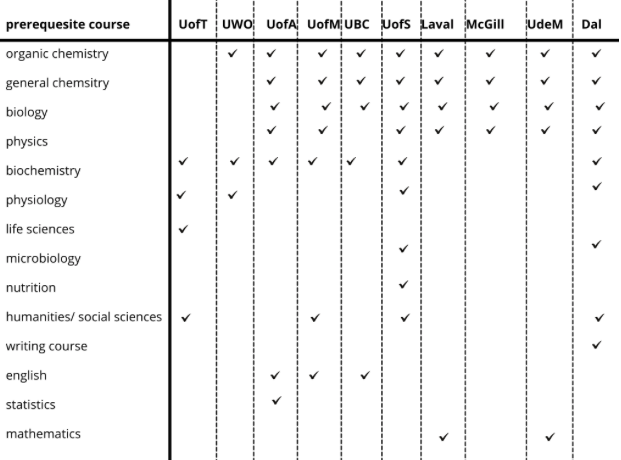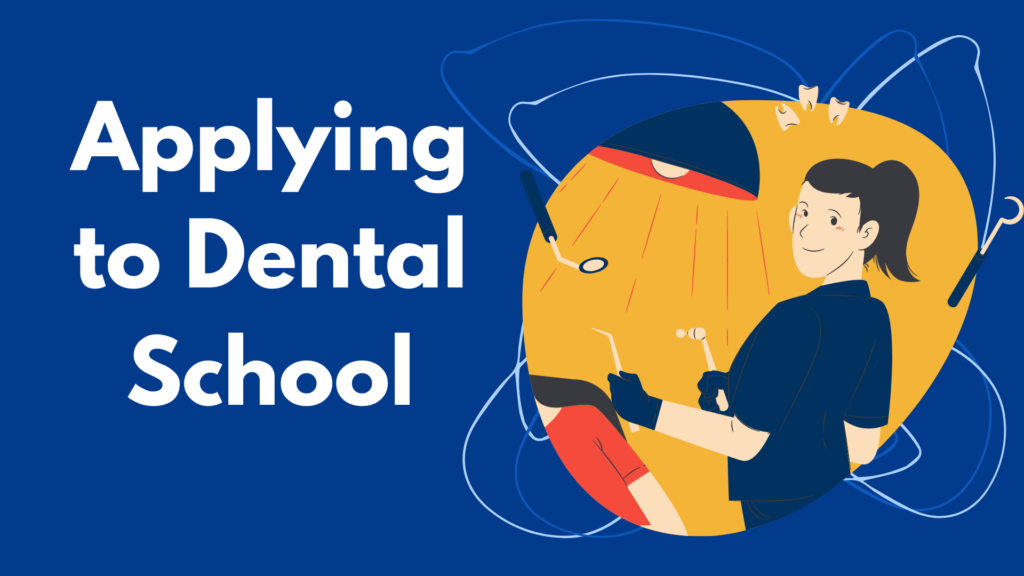If you’ve ever Googled “How to apply for dental school,” “What are the dental school prerequisites,” or “What is the DAT,” then this is the post for you. Here, we walk you through the dental school application process, covering the dental school admissions requirements for both Canada and the United States.
Keep in mind that this post is representative of the data available in 2021. As such, it may provide a helpful guide for dental school admissions requirements but it may not be entirely accurate in future years as dental schools may update their admissions requirements from year to year.
Because of these potential updates, it’s important that you frequently check the websites of the schools you want to apply to in order to make sure you fulfill all of their requirements. You don’t want to start your application only to discover you’re missing a prerequisite or two!
With this in mind, let’s get into the dental school application process.
APPLYING TO DENTAL SCHOOL
Each dental school may either use their own application system through their websites or they may be part of a centralized service like the Ontario Universities Application Centre (OUAC) in Canada or the Associated American Dental Schools Application Service (AADSAS) in the U.S. Regardless, there are three elements that must be submitted as part of every application:
- Academic transcript
Admissions committees will use your transcript to assess various aspects of your application. It will be used to calculate your GPA as well as to identify whether or not you completed the necessary prerequisites and whether your semesters were full-time or part-time.
- Dental Aptitude Test (DAT) scores
Analogous to medical schools’ MCAT or law schools’ LSAT, the DAT is a standardized entry exam that dental school applicants must take. It can be taken any number of times, though keep in mind that your application will display how many times you took the exam. There is both a Canadian and an American DAT and there are some differences between the two versions. While most American schools will only accept the American DAT, some Canadian schools will accept either version. Keep reading to get a little more information about the structure of the DAT.
- Personal statement
Your personal statement is your opportunity to discuss your non-academic qualities that would make you a good candidate for dental school. Use this as a chance to showcase your individuality but make sure it is well-written. The way you present your information is just as important as the information itself.
Looking for a bit more information on your dental school application? Read on to get a little more clarity on what’s required of you.
PREREQUISITES
Out of all of the admissions requirements, a school’s prerequisites are the most likely to change from year to year. In this section, we give you an overview of different dental school prerequisites in Canada and the U.S in 2021.
There are 10 dental schools in Canada, and many of them require different prerequisites. The following chart gives an overview of what each school requires:

In the U.S., there are 68 dental schools, and their prerequisites are similar to those in Canada, generally including:
- 8 hours of Biology with labs
- 8 hours of Physics
- 8 hours of English
- 8 hours of General Chemistry with labs
- 8 hours of Organic Chemistry with labs
PERSONAL STATEMENT
Your applications for U.S. and Canadian dental schools will both require a personal statement. Your goal when writing it is to distinguish yourself from other applicants. A high GPA and DAT score are great, but most applicants also have a high academic standing. This is your opportunity to highlight your stand-out qualities and tell your story in a way that resonates with the committee and leaves them wanting to learn more.
This is your opportunity to discuss the qualities you possess that will help you excel in dental school and in your career as a dentist. Be specific, highlighting qualities such as your leadership skills, your communication skills, your ability to work well under pressure, or your ability to work with people from different backgrounds.
You might think this would be the place to represent yourself as a jack of all trades, the kind of person who has done everything and can tackle any challenge. But the truth is that admissions committees are looking for unique qualities. So, when writing your personal statements, ask yourself what your passions are, what qualities make you a singular individual, and write about those. Be sure to tie it all back to your interest in dentistry and why you are the right candidate for their school.
DENTAL APTITUDE TEST (DAT)
The DAT is required for entry to both Canadian and American dental schools. As we previously mentioned, there is no limit on the number of times you can take it. However, while taking the exam multiple times can demonstrate your dedication and perseverance, this would only interest dental schools if your score improves each time. Otherwise, it is best to wait until you are confident you can do well before taking the DAT.
While the Canadian and American DAT are very similar, they do differ slightly in some respects.
Canadian DAT
The Canadian DAT is made up of three mandatory sections and one optional section.
Section one is all about the natural sciences, covering subjects such as cell metabolism, physiology, genetics, and atomic and molecular structure. It’s composed of 70 questions that must be completed within 60 minutes.
Section two is considered the most challenging by many students. It tests your perceptual ability by asking you questions about a specific pattern’s corresponding 3D shape. Visuospatial skills are incredibly important to a dentist’s day-to-day tasks, such as reading x-rays or filling cavities. This 90-question section must also be completed in 60 minutes.
Next comes the 50 minute reading comprehension section. You are given a passage to read and then you are presented with a series of related questions. You don’t have to have any previous knowledge or familiarity with the subject on which the passage and questions are based. The point is to understand what you are reading and extract the appropriate pieces of information to help you answer the questions. Strong analytical and communication skills are important for doing well on this section.
The last section of the DAT is optional and tests students’ manual dexterity. The test involves carving a given model out of a bar of soap within 30 minutes. Not all dental schools require you to complete this section, so it is important to double check the application requirements for your chosen dental schools before taking the exam.
Most Canadian dental schools do not have a minimum required DAT score. However, a competitive overall average score for Canadian schools is around 19. For those that do have minimum DAT requirements, they typically require a score of about 15 per section.
American DAT
While the American DAT is fairly similar to its Canadian counterpart, it does contain a few differences worth noting:
- The natural sciences section includes a portion on organic chemistry.
- The exam also includes a 40 minute section on quantitative reasoning, which involves both mathematical questions and word problems.
- There is no manual dexterity portion.
There is a broader range in minimum eligible DAT scores for American schools than there is for Canadian schools. The range for American schools is between 15 and 23 overall. Be sure to double check the minimum required scores for the schools you plan to apply to.
PERSONAL INTERVIEW
After you have submitted your application, you might be called in for an interview. This is good news! It means your application resonated with the admissions committee and they want to get to know you better.
While interviews may seem unpredictable, there’s lots that you can do to prepare. Here are some tips to help you get ready:
- Research the school where you’ll be interviewing. This makes a good impression on your interviewers as it demonstrates that you are genuinely interested in attending their school.
- Figure out which interview format each dental school uses. This information is usually found on the schools’ websites and it can help you better prepare.
- Once you have an idea of what format to expect, look up both common and uncommon dental school interview questions and scenarios. You can use these as practice to improve your communication skills and eliminate (or at least minimize) filler words like “um” and “like.”
- Speak with alumni. They have undergone this process before you and can give you the inside scoop on what to expect.
- Speak with professional advisors or seek out interview preparation courses. These will ensure that you are fully prepared, thus calming your nerves and improving your overall interview performance.
- Prepare your own questions to ask during the interview. This is as much your opportunity to determine if they are the right school for you as it is their opportunity to determine if you are the right candidate for them. It will also demonstrate that you are prepared, professional and that you’re taking this opportunity seriously
Looking for a few more interview tips? Check out our top five interview tips!
The personal interview is the last step standing between you and admission to dental school. It’s good etiquette to send your interviewers a thank you email post-interview. Then all that’s left is to keep a look out for any follow-up phone calls or emails that you may receive.
Remember, though applying to dental school seems daunting, with the right guidance and preparation, it doesn’t have to be. You don’t have to figure all of this out on your own. Reaching out to alumni or professional admissions experts at any stage of this process can help you tremendously.
Book a free consultation with one of our specialists today to find out how we can support you through your application process.

